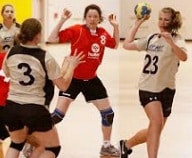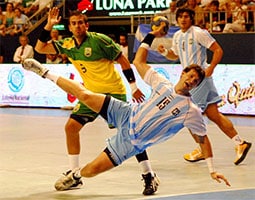 In the field of sport , the notion of pass refers to the action that is carried out with the objective of delivering the ball to a teammate . The shoulder , on the other hand, is the lateral and upper sector of a person's trunk , where the arm begins.
In the field of sport , the notion of pass refers to the action that is carried out with the objective of delivering the ball to a teammate . The shoulder , on the other hand, is the lateral and upper sector of a person's trunk , where the arm begins.
Starting from these ideas, we can focus on the definition of a shoulder pass . This is what a common movement in handball or handball is called.
To perform a shoulder pass, the athlete must take the ball with one hand, raise it over his shoulder and finally throw it towards a teammate . Throwing from above the shoulder helps give it power .
It is important to keep in mind that the pass, in handball, is key for the ball to circulate around the court and create spaces in the defense . To be effective, it has to be directed towards the chest of the teammate with a certain force so that it is not intercepted and it must accompany the movement of the receiver (if the player is heading to the left, for example, the pass has to consider that trajectory ). .
In short, if it were not for the pass, handball would not be a team game, as much as soccer or basketball , since this series of techniques allows control of the ball to be distributed among several players. This opens the doors to two essential phenomena of the game: that each one assumes their specific role on the field; that the team takes advantage of the strengths of each player in key moments.
Both phenomena are necessary to increase the chances of victory in a confrontation. The roles that are distributed so that the team functions as a large unit capable of carrying out several simultaneous actions: protecting the goal, receiving the ball thrown by the goalkeeper to start an attack , opening the defenses and generating attack possibilities, stopping attacks in progress and open holes in the opposing formation, etc.
Thanks to the over-the-shoulder pass, the chances of the ball reaching the teammate you have chosen as the receiver who performs it increase, thanks to the greater power of the throw compared to other passes. Even if the ball is intercepted before it reaches its destination, the force and precision required to catch it before it continues its trajectory must be greater than for a less powerful pass, and so it is likely to fly off in an arbitrary direction , giving the team a few seconds to rethink the play.
 The shoulder pass, in this framework, is the most frequent. Also called a direct pass , its execution technique is identical to the throw that is carried out with the intention of scoring a goal .
The shoulder pass, in this framework, is the most frequent. Also called a direct pass , its execution technique is identical to the throw that is carried out with the intention of scoring a goal .
Due to its characteristics , the shoulder pass is usually safe. Other types of passes are the sash pass , the pique pass , the underhand pass and the underhip pass , each with its own particularities.
Handball has a very particular history. Although the version we know today dates back to the beginning of the 20th century, there are several very old games that have more than one similarity with it. Already in ancient Greece and Rome there were sports in which the hands were used to carry the ball; Two clear examples are the Greek urania game and the Roman harpastum .
It is believed that the first games of this type prioritized the use of the hands to control the ball because the dexterity of the legs took longer to develop , from an evolutionary point of view.
